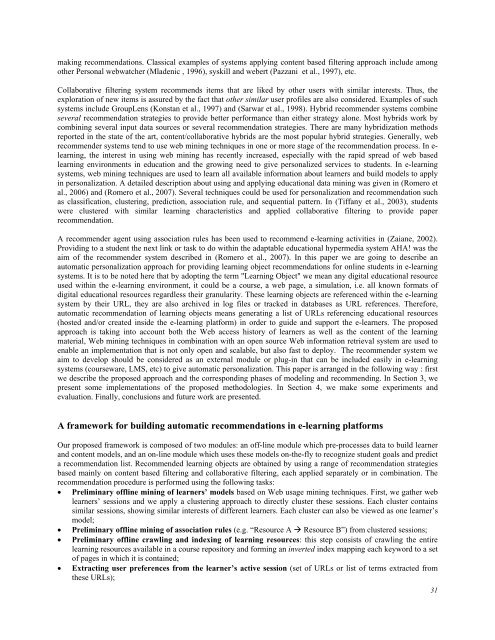October 2009 Volume 12 Number 4 - Educational Technology ...
October 2009 Volume 12 Number 4 - Educational Technology ...
October 2009 Volume 12 Number 4 - Educational Technology ...
You also want an ePaper? Increase the reach of your titles
YUMPU automatically turns print PDFs into web optimized ePapers that Google loves.
making recommendations. Classical examples of systems applying content based filtering approach include among<br />
other Personal webwatcher (Mladenic , 1996), syskill and webert (Pazzani et al., 1997), etc.<br />
Collaborative filtering system recommends items that are liked by other users with similar interests. Thus, the<br />
exploration of new items is assured by the fact that other similar user profiles are also considered. Examples of such<br />
systems include GroupLens (Konstan et al., 1997) and (Sarwar et al., 1998). Hybrid recommender systems combine<br />
several recommendation strategies to provide better performance than either strategy alone. Most hybrids work by<br />
combining several input data sources or several recommendation strategies. There are many hybridization methods<br />
reported in the state of the art, content/collaborative hybrids are the most popular hybrid strategies. Generally, web<br />
recommender systems tend to use web mining techniques in one or more stage of the recommendation process. In elearning,<br />
the interest in using web mining has recently increased, especially with the rapid spread of web based<br />
learning environments in education and the growing need to give personalized services to students. In e-learning<br />
systems, web mining techniques are used to learn all available information about learners and build models to apply<br />
in personalization. A detailed description about using and applying educational data mining was given in (Romero et<br />
al., 2006) and (Romero et al., 2007). Several techniques could be used for personalization and recommendation such<br />
as classification, clustering, prediction, association rule, and sequential pattern. In (Tiffany et al., 2003), students<br />
were clustered with similar learning characteristics and applied collaborative filtering to provide paper<br />
recommendation.<br />
A recommender agent using association rules has been used to recommend e-learning activities in (Zaiane, 2002).<br />
Providing to a student the next link or task to do within the adaptable educational hypermedia system AHA! was the<br />
aim of the recommender system described in (Romero et al., 2007). In this paper we are going to describe an<br />
automatic personalization approach for providing learning object recommendations for online students in e-learning<br />
systems. It is to be noted here that by adopting the term "Learning Object" we mean any digital educational resource<br />
used within the e-learning environment, it could be a course, a web page, a simulation, i.e. all known formats of<br />
digital educational resources regardless their granularity. These learning objects are referenced within the e-learning<br />
system by their URL, they are also archived in log files or tracked in databases as URL references. Therefore,<br />
automatic recommendation of learning objects means generating a list of URLs referencing educational resources<br />
(hosted and/or created inside the e-learning platform) in order to guide and support the e-learners. The proposed<br />
approach is taking into account both the Web access history of learners as well as the content of the learning<br />
material, Web mining techniques in combination with an open source Web information retrieval system are used to<br />
enable an implementation that is not only open and scalable, but also fast to deploy. The recommender system we<br />
aim to develop should be considered as an external module or plug-in that can be included easily in e-learning<br />
systems (courseware, LMS, etc) to give automatic personalization. This paper is arranged in the following way : first<br />
we describe the proposed approach and the corresponding phases of modeling and recommending. In Section 3, we<br />
present some implementations of the proposed methodologies. In Section 4, we make some experiments and<br />
evaluation. Finally, conclusions and future work are presented.<br />
A framework for building automatic recommendations in e-learning platforms<br />
Our proposed framework is composed of two modules: an off-line module which pre-processes data to build learner<br />
and content models, and an on-line module which uses these models on-the-fly to recognize student goals and predict<br />
a recommendation list. Recommended learning objects are obtained by using a range of recommendation strategies<br />
based mainly on content based filtering and collaborative filtering, each applied separately or in combination. The<br />
recommendation procedure is performed using the following tasks:<br />
Preliminary offline mining of learners’ models based on Web usage mining techniques. First, we gather web<br />
learners’ sessions and we apply a clustering approach to directly cluster these sessions. Each cluster contains<br />
similar sessions, showing similar interests of different learners. Each cluster can also be viewed as one learner’s<br />
model;<br />
Preliminary offline mining of association rules (e.g. “Resource A Resource B”) from clustered sessions;<br />
Preliminary offline crawling and indexing of learning resources: this step consists of crawling the entire<br />
learning resources available in a course repository and forming an inverted index mapping each keyword to a set<br />
of pages in which it is contained;<br />
Extracting user preferences from the learner’s active session (set of URLs or list of terms extracted from<br />
these URLs);<br />
31

















